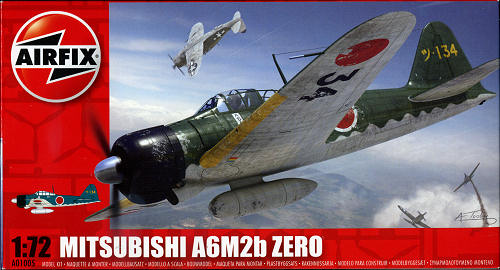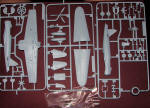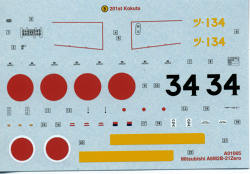
Airfix 1/72 A6M2b
| KIT #: | A01005 |
| PRICE: | $6.99 SRP |
| DECALS: | One option |
| REVIEWER: | Scott Van Aken |
| NOTES: | New tool kit |

| HISTORY |
The A6M2
While the Navy was testing the first two prototypes, they suggested that the third be fitted with the 700 kW (940 hp) Nakajima Sakae 12 engine instead. Mitsubishi had its own engine of this class in the form of the Kinsei, so they were somewhat reluctant to use the Sakae. Nevertheless, when the first A6M2 was completed in January 1940, the Sakae's extra power pushed the performance of the Zero well past the original specifications.
The new version was so promising that the Navy had 15 built and shipped to China before they had completed testing. They arrived in Manchuria in July 1940, and first saw combat over Chungking in August. There they proved to be completely untouchable by the Polikarpov I-16s and I-153s that had been such a problem for the A5Ms currently in service. In one encounter, 13 Zeros shot down 27 I-15s and I-16s in under three minutes without loss. After hearing of these reports the Navy immediately ordered the A6M2 into production as the Type 0 Carrier Fighter, Model 11. Reports of the Zero's performance filtered back to the US slowly. There they were dismissed by most military officials, who felt it was impossible for the Japanese to build such an aircraft.
After the delivery of only 65 aircraft by November 1940, a further change was worked into the production lines, which introduced folding wingtips to allow them to fit on aircraft carriers. The resulting Model 21 would become one of the most produced versions early in the war. When the lines switched to updated models, 740 Model 21s had been completed by Mitsubishi, and another 800 by Nakajima. Two other versions of the Model 21 were built in small numbers, the Nakajima-built A6M2-N "Rufe" floatplane (based on the Model 11 with a slightly modified tail), and the A6M2-K two-seat trainer of which a total of 508 were built by Hitachi and the Sasebo Naval Air Arsenal. Such was the war situation, that many A6M2 aircraft were still being used as defensive fighters on various islands and back in Japan when replaced by newer versions.
| THE KIT |
 Not
something you would think would be needed, thanks to the very nice Hasegawa
Zeros, but those are getting more and more pricey, hence Hornby felt that a new
tool needed to be added to the catalog to replace the truly ancient original
took Zero from the 60s. This has the now standard large engraved detail with the
usual option to have the gear molded up. For this you will need to buy the
display stand from Hornby as it does not come with the kit.
Not
something you would think would be needed, thanks to the very nice Hasegawa
Zeros, but those are getting more and more pricey, hence Hornby felt that a new
tool needed to be added to the catalog to replace the truly ancient original
took Zero from the 60s. This has the now standard large engraved detail with the
usual option to have the gear molded up. For this you will need to buy the
display stand from Hornby as it does not come with the kit.
Cockpit is nicely done with a decal for the
instrument panel. A single piece canopy sits atop it. The kit also comes with an
additional option and that is to model it with the wing tips folded. For this
one will need to saw off the extant wing tip, but the mounting holes are already
molded in  place,
invisible until you cut off the wing tip, making this an easy option. The kit
provides a drop tank with its faired in mount. Fortunately, one needs to open a
hole for this tank so the model can be built with a smooth underside.
Personally, I like options and bristle when a kit is designed with all these
holes opened up already. The engine and cowling are well molded. My prop was
badly bent in shipment but thanks to the semi-soft plastic, was easily
straightened out.
place,
invisible until you cut off the wing tip, making this an easy option. The kit
provides a drop tank with its faired in mount. Fortunately, one needs to open a
hole for this tank so the model can be built with a smooth underside.
Personally, I like options and bristle when a kit is designed with all these
holes opened up already. The engine and cowling are well molded. My prop was
badly bent in shipment but thanks to the semi-soft plastic, was easily
straightened out.
Since this is a series one kit, there is only one markings option. That is for the box art plane from the 201st Kokutai based at Tobera in New Britain. The decals are very nicely printed and include the wing leading edge ID band. Considering where it was based, I would expect that this plane was actually pretty worn so you may wish to keep that in mind.
| CONCLUSIONS |
| REFERENCES |
http://en.wikipedia.org/wiki/Mitsubishi_A6M2
Thanks to me for picking this one up.
If you would like your product reviewed fairly and fairly quickly, please contact the editor or see other details in the Note to Contributors.
Back to the Previews Index Page